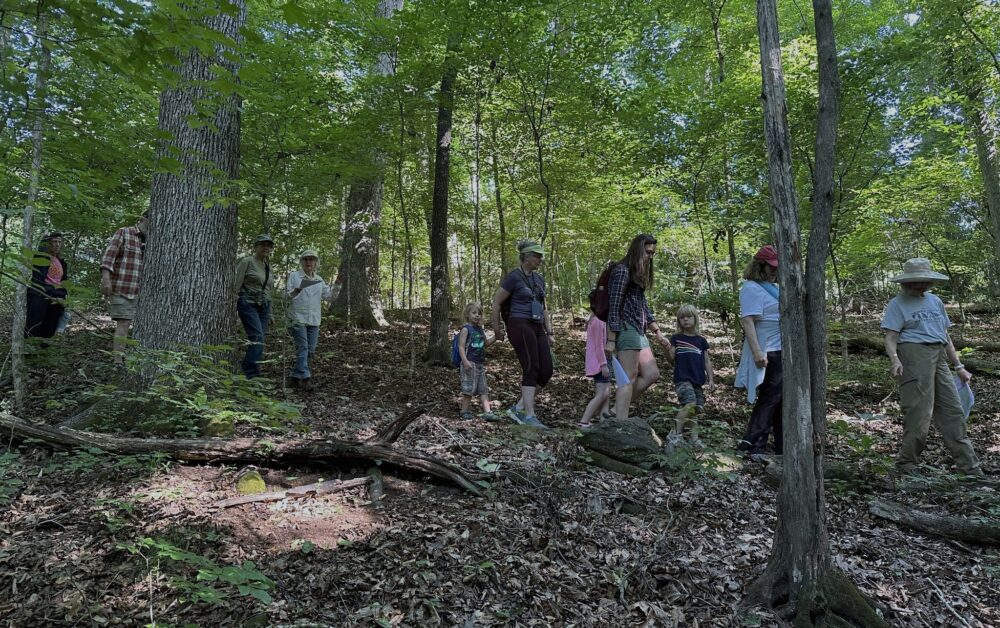Today was cool and no rain although our
ramble on the Purple and Orange Trails was muddy. Before starting off, Dale read some passages
about Sourwood from A Natural History of
Trees of Eastern and Central North America by Donald Culross Peattie; the
full text follows for your enjoyment:
The
glittering leaves of the Sourwood, wondrously fresh-looking and spirited, have
completed their growth long before the flowers appear, yet so handsome are the
great bouquets of bloom at the ends of the branches that they are not put out
of countenance by the splendid foliage but, looking like hundreds of little
lilies-of-the-valley, they sway and dance in the warm, friendly wind of late
June and early July. In case you have not looked up and seen them, you may soon
be made aware of them by the roar of the bees gone nectar-mad at their lips.When
autumn comes, the foliage turns a gorgeous scarlet or orange or crimson, double
welcome because the Sourwood in general grows outside the range of the Sugar
Maple and the Aspen, and takes their place in the South. Then, especially in
the southern Appalachians where Sourwood grows 50 and 60 feet tall, is the
season to set out afoot, or on horseback, or in your car, to buy sourwood honey
from your country neighbors. Some of them put out little signs along the roadside,
but all you have to do is watch for a row of “bee gums” not far from the
farmer’s house. For if the southern farmer has hives at all, he has Sourwood
honey for sale. Fortunately the blooming period of the Sourwood is just after
the fading of the Mountain laurel and Rhododendron whose honeys are poisonous.
Their honey the bee-keeper throws away, but he is very careful to store his
sourwood honey, for it is the finest, in the opinion of many epicures, in the
southeastern states and is not surpassed even by the most tangy sage honey of
California.Sourwood
honey is medium-light in color, of heavy body, and slow to granulate. An
average flow of as high as 75 pounds per colony from Sourwood has been
recorded. Usually the local demand takes the entire crop at prices above the
open market, so that Sourwood is a honey like some of the choicest wines of the
vineyards of Europe – that is, it practically does not appear upon the market
at all and can be had only by those epicures who will journey far to partake of
it. One buys Sourwood honey as one buys any such rare product from its
producers – not in a commercial spirit, paying for it and carrying away the
wares – but with all the due ceremony observed between a collector and a
creative artist. You ride up to the cabin door; a woman appears at the barking
of the hounds, with children peeping out from behind her skirts, and mountain
courtesy requires that you begin, not by stating your business but by telling
where you come from. Then you assure her that she has a “right pretty place”;
you praise her portulacas, her turkeys, and so, across the landscape, you
arrive at her bee gums. Then you ask if she likes Sourwood honey as much as you
do. You tell her that you would go far to obtain a little if only you could
find somebody who would give up a few pounds of it. When the honey is produced,
as it certainly will be, you accept it before asking the price. This will be
shyly stated. You may safely pay it for your haggling was all done, by
indirection, in your previous parley. And you are paying no more than a fico
for nectar and ambrosia.The
very hard wood scarcely enters into the lumber business but is cut locally by
farmers for the handles of tools. Once on a time in the days of home medicine,
the leaves were brewed as a tonic, and they still, with their pleasant acid
taste, quench the thirst of the hot, perspiring mountain climber.
Then Carol read from Nature’s Chaos by Eliot Porter and James Gleick, p. 47:
Sometimes
people try to create miniature ecosystems, mimicking on a smaller scale what
the earth has created on a grand one. One
experiment in the American Southwest has brought thousands of species together
in a domed world. Simultaneously, the
national park system is learning a hard lesson.
To support a single large mammal, a cougar or grizzly bear, nature
requires hundreds of square miles of an intricate mesh of smaller species. To support a whole, thriving population of
such animals, the better part of a continent may be necessary. Even the great national parks, it now seems,
cannot sustain them. The populations are
dwindling and vanishing. A stripped-down
ecology may be no more plausible than a poet with a brain of a mere million
bits. Our imaginations may have been
beggared by the monumental built-up hierarchies required to create the
apparently simple manifestation of one herd of buffalo, one stand of dogwood.
As we went by the International Bridge in
the International Garden some found a water snake. Others of us missed it. We all saw the beautiful Lotus blossoms.
